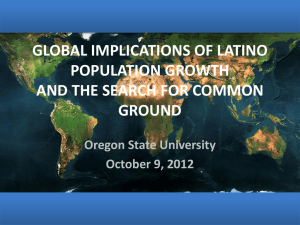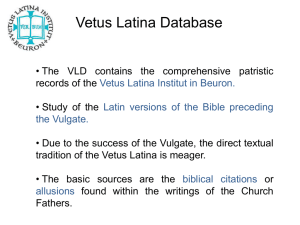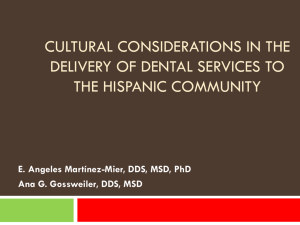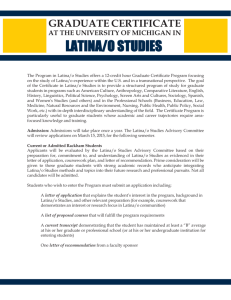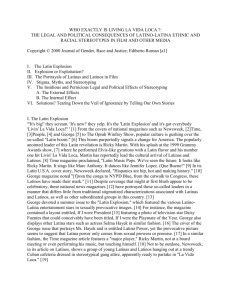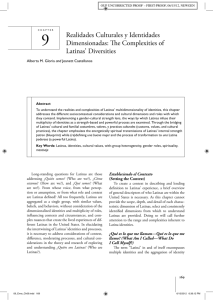Understanding the Cultural Context of Cultural Responsiveness
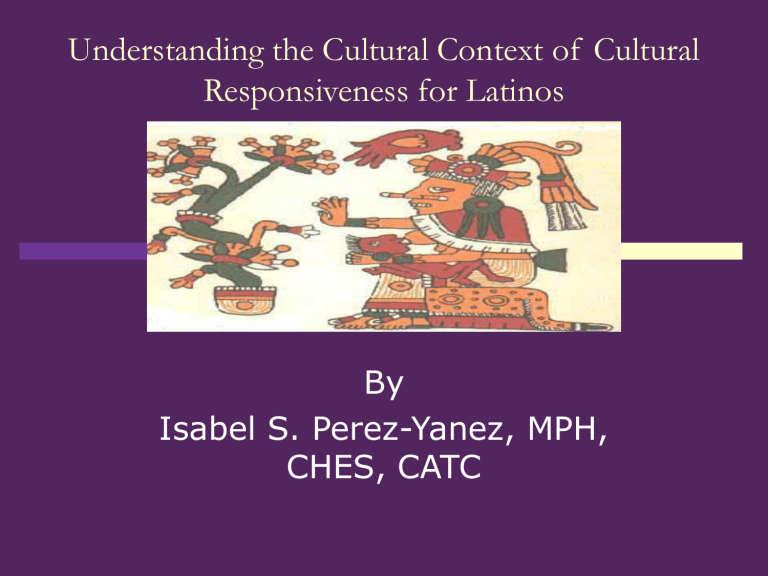
Understanding the Cultural Context of Cultural
Responsiveness for Latinos
By
Isabel S. Perez-Yanez, MPH,
CHES, CATC
Focus of Presentation
Overview of Latino Trends
Cultural Context Perspective
Cultural Responsiveness not a Trend
Hope, Health and Healing
Myth of Cultural Competency
Competent implies we have reached a level of competency
Diverse meanings; sensitivity, diversity, human diversity, tolerance
Diversity promotes separation
What is culture?
Responsive services
What are they?
Meet needs of the client
Consider ecological factors
Do not compartmentalize
Evaluates physical, psychological, emotional and spiritual needs of clients
Evaluates client social, relational and cultural strengths and needs
Respectful
Culturally attuned
Yvette G. Flores, Ph.D.
Understanding the Cultural Context for
Responsive services
What are they?
Meet needs of the client
Consider ecological factors
Do not compartmentalize
Evaluates physical, psychological, emotional and spiritual needs of clients
Evaluates client social, relational and cultural strengths and needs
Respectful
Culturally attuned
Yvette G. Flores, Ph.D.
Factors Effecting the Lives of Latinos
Individual
Family
Cultural Values
Collectivism/
Interdependence
Migration
Environment
Systems &
Institutions
Laws and Policies
Stereotypes,
Racism,
Oppression
Hispanics Account for More than Half of
Nation's Growth in Past Decade
The 2010 Census counted 50.5 million Hispanics
California at Glance
Hispanic Population
13,682,000
Hispanics as Percent of State Population
37%
Median Age of Hispanics
27
Median Income, Hispanics
16+
$20,500
Poverty Rate,
Hispanics 17 and Younger
27%
Hispanics Without
Health Insurance
29%
Hispanic Homeownership
45%
Hispanics as Percent of
All K-12 Students
49%
Source: PEW Hispanic
Center
www.latina.org
Diversity Amongst Latinas/Latinos
We are Mexicans, Honduran, Puerto
Ricans, Argentineans, Cuban,
Salvadorans, Dominicans, Panamanians,
Guatemalans, Nicaraguans, Peruvians,
Costa Ricans, Bolivians, Chileans,
Colombians, Venezuelans and more………
Black, white, rainbow of colors and different racial preferences
Source: Latinas/os in the United States: Changing the Face of America
Diversity Amongst Latinas/Latinos
What we call ourselves
Mostly Catholics, Protestants, Jewish, Islamic, atheists, Santeros/as Curanderos/as
Born here prior to this land became United States
Born here after, fairly recent arrivals
Speak only English, bilingual, only Spanish,
Mayan Languages, and other languages
Source: Latinas/os in the United States: Changing the Face of
America
Traditional Hispanic Values, Characteristics, Behavior
Patterns
Family Values (familismo) very important, respect & loyalty
Cooperation rather than competition
Interpersonal relationships very important
Deep respect and affection among friends and family
Strictness of child rearing, religiosity, respect for adults
Extended family, non-blood relatives
Father (responsible) children (obedient) god- parents (resourcefulness
Source: Counseling Culturally Diverse, Theory and Practice, 5 th Edition,
Derald Wing Sue, David Sue
Migration
• Despite policy changes and the increased militarization of the U.S.-Mexico border, thousands of men and women continue to make the journey north
• Generally the migration is motivated to improve the living conditions of their families left behind
• Post migration alcohol and drug use is likely to increase
• Migration is considered a significant risk factor for both those who leave and those who remain
Source: Yvette G. Flores, Ph.D.
University of California, Davis
Chicana & Chicano Studies
Program
Buying Power
Latinas/Latinos’ buying power increased from
$211.9 billion in 1990 to $978.4 billion in 2009
Projected to climb to $1.3 trillion in 2014.
The percentage change between 1990 and 2014 is 528%, the highest of all race/ethnic groups
Share of the consumer market was 9.1% in 2009
Source: Changing workplaces. Changing Lives, Catalyst, March 2010
Language at
Home: Persons 5 and Older
Only English
Spoken at Home
Language Other than Only English
Spoken at Home
2,794,000
(23%)
9,420,000
(77%)
Higher Education Degrees
From 2000 to 2004 number of collegebound Hispanic women increased by
22%-6% increase or more over Latinos
Source: WomensColleges.org
In 2006-2007-For Latinos/Latinas
7.5% getting bachelor’s
5.8% getting master’s degrees
3.4% getting PhD’s
Source: Changing workplaces. Changing Lives, Catalyst, March 2010
Remitance Senders and Recievers
6 million immigrants from Latin America send families back home
Flow from U.S. to Latin America and the
Caribbean close to $30 billion
Continue to increase
Culture and class as determining variables
Latino diversity derives from differences in class, education, and value systems
Values can be traditional, transitional or contemporary values
Values are influenced by the person’s relationship to the means of production
At any given time, values and class interact to influence specific behaviors, attitudes or practices
Source: Bernal & Alvarez
19
Substance Abuse Patterns
Binge Drinking –Latinos have a rise in numbers now higher than the national average
U.s. born Hispanic Americans higher rates of substance abuse compared to those born in their native born
More acculturated to the American culture , higher substance abuse pattern
Research and News, August 3, 2010, SAMHSA
Latinos and Treatment
Hispanics are among the highest percentages of those needing but not receiving treatment compared with their respective percentage of the total in treatment.
Have the next highest percentage of needing but not receiving treatment for illicit drug or alcohol use
Hispanics showed a pattern of steady increase of admissions
Source: 2010 California Needs Assessment Report
Substance Abuse & Other Issues
Substance abuse is the most common behavioral risk factor reported by patients with TB in the U. S.
Hispanics and Asian/Pacific Islander account for 82% of
TB Cases in California in 2008
Latinos were second highest arrested for misdemeanor drug offense for Marijuana, Other drugs, public intoxication, and liquor laws
45.6% adult and juvenile were arrested for felony and misdemeanor DUI age 12 and up
Latinos were second highest for at risk gambling, problem gamblers, pathological gambling
Source: 2010 California Needs Assessment Report
Latina Population Type of Service, 2005
Long-Term Residential 18. 5%
Short-term Residential 1.1 %
Day Treatment/ Intensive outpatient 8.4%
Outpatient Treatment 62. 2%
Detox-Residential 5.5%
Detox-Hospital 0.0%
Detox-outpatient 4.3%
Source: Resources for Latina Population, California Women Children and
Families TA Project, A project of Children and Family Futures, Funded by the California Dept of Alcohol & Drug Programs, Marta Ortegon and
Deborah Werner
Primary Drug of Choice, 2005
51% -Methamphetamine
15% Heroin
14% Alcohol
12% Marijuana/Hashish
8% Other
Source: Resources for Latina Population, California Women Children and
Families TA Project, A project of Children and Family Futures, Funded by the California Dept of Alcohol & Drug Programs, Marta Ortegon and
Deborah Werner
Incarceration Rates
Between 1991 and 2007- number of offenders sentenced in federal courts doubles (118%)
During the same period, Hispanic offenders nearly quadrupled 270% from 7, 924 in 1991 t0
29, 281 in 2007.
Hispanics accounted for more than half (54%) of the growth in the number of sentenced federal offenders over this period.
PEW Hispanic Center, February 18, 2009
Public Policy Institute of California, July 2011
Sources: California Department of Corrections and Rehabilitation data, 2010:
Census Bureau data. 2010. From: Just the Facts: California’s Changing Prison
Population, PPIC. 2011.
Latina and Substance Abuse Treatment
In 2005, 15, 287 Latinas entered treatment for alcohol and other drug problems
74% -Mexican, 22 % Other Hispanic/Latino, 2%
Puerto Rican
7% identified were pregnant at time of admission
53% of Latina admissions were under 30 years
Source: Resources for Latina Population, California Women Children and
Families TA Project, A project of Children and Family Futures, Funded by the California Dept of Alcohol & Drug Programs, Marta Ortegon and
Deborah Werner
Dropout rates for White youth have remained below the rates for other racial/ethnic groups
Juvenile Offenders and Victims: 2006 National
Report NCJJ/OJPP
Stereotyping Latina Adolescents
Despite this popular perception, most
Latina girls do not fit the negative images typically portrayed in the media.
Latina Girls, Voices of Adolescent Strength in the United States, Jill Denner , Bianca L. Guzman
Most research focuses on negative issues.
Stereotyping Latina Adolescents
The common perception of a Latina adolescent is a girl who makes poor choices and who will likely drop out of school, become a teenage mother, or be the girlfriend of a gang member.
Latina Girls, Voices of Adolescent Strength in the United States, Jill Denner , Bianca L. Guzman
Punitive instead of positive
While Hispanic-Latino youth are less likely to receive mental health services, they are more likely to become involved with the juvenile justice and/or child welfare systems (Vega & Alegria, 2001).
Types of Trauma Stress
Community and
School Violence
Complex Trauma
Domestic Violence
Medical Trauma
Natural Disasters
Neglect
Physical Abuse
Refugee and War
Zone Trauma
Sexual Abuse
Terrorism
Traumatic Grief
National Child
Traumatic Stress
Network
Provider characteristics
Cultural incompetence
Lack of information about Latinas
Stereotyping & over generalizing
Racial/ethnic/class differences
Perception of Latinas as “the other”, foreigners, trespassers, overly reproductive
Differences in world views
Linguistic differences
Yvette G. Flores, Ph.D.
Perceived Discrimination In US
Growing scientific evidence that the subjective experience of discrimination is detrimental to the mental health and physical health of women, ethnic/racial minorities, and the poor.
Perceived discrimination (PD) is the subjective experience of being treated unfairly relative to others in everyday experience.
Journal of Health and Social Behavior,
Kessler, Williams,1999
Types of Racism-Related Stress
Racism-related life event - significant life experiences across various domains.
Vicarious racism experiences - through observation and report from family, friends, and even strangers.
Types of Racism-Related Stress
Daily racism microstressors microaggressions-degradations, put downs, slights, exclusions-being ignored, disrespected, observed, stereotyped.
Chronic-contextual stress - impact of social structure, political dynamics, institutional racism.
Stress and Discrimination
Growing evidence that exposure to discriminatory experiences is an ongoing aspect of life for
Latinos in and the Mexican-Origin population within the U.S.
Gender differences in Discrimination and Health
In addition to general stress discrimination stress as an ethnic minority places them at increased risk for health and mental health problems
Source: Perceived Discrimination, Perceived Stress, and Mental and
Phsycial Health Among Mexican-Origin Adults, Floret, Tschann, Dimas,
Bachen, Pasch, de Groatl August 2008
Stress and Discrimination
Cumulative exposure compromises psychological well-being and physical health
Need to include assessments for the effects of discrimination stress with other chronic stress relevant to this population
Source: Perceived Discrimination, Perceived Stress, and Mental and Physical Health Among Mexican-Origin Adults, Floret,
Tschann, Dimas, Bachen, Pasch, de Groatl August 2008
Education
Schools frequently punished students with the greatest academic , social, and emotional needs.
Most likely to be suspended, expelled, or removed from the classroom for punishment, reveals that minorities,
(Blacks and Latinos) males, and low achievers are vastly overrepresented.
Source: Pedro Noguera PH.D, NYU. Schools, Prisons, and Social
Implications of Punishment
Cannot forget the “ divide and conquer” fall into the trap of racism within our own culture “ as long as people of color fight among themselves, they can’t form alliances confront the establishment.”
Counseling the Culturally Diverse, Theory and Practice, 5 th Edition, Derald Wing Sue, David Sue
Traditional Counseling
Counseling and Therapy have oppressed, harmed, damaged marginalized people
(often unintentionally)
Counseling Culturally Diverse, Theory and Practice, 5 th Edition, Derald Wing Sue, David Sue
Professional Education and Training
Focus tends to be on pathological lifestyles and/or maintenance of false stereotypes
Ethnocentric bias been highly destructive to natural help giving networks of minority communities
( Duran, 2006) Counseling Culturally Diverse, Theory and Practice, 5 th Edition, Derald Wing Sue, David Sue
5% Rule
Source: UCD-Civil Rights Training
Guiding Principles for
Gender-Responsive Services
•
•
•
•
•
•
Gender
Environment
Relationships
Women’s Services
Economic & Social Status
Community
Copyright © 2009, Stephanie S. Covington, Ph.D.
Cultural Context
& Social Justice
Juvenile justice system must be purged of the class and race discrimination that sends disproportionate numbers of poor kids and kids of color to Juvenile Hall--and eventually prison. Dirty - Meredith
Maran
Five Characteristics of Effective Helping
Professionals
Worldview Respect
Hope
Humility
Trust
Empathy
Adapted from Fundamentals of Substance Abuse Practice, Jerry L. Johnson
Advice to Clinicians and Administrators in Substance
Abuse Treatment
Clinical
Acculturation
Express own feelings about heritage and self-perception
Encourage exploration of strengths of cultural backgrounds, histories, heritages, old & new ways to incorporate spirituality into their lives
Adopt acculturation assessment tools that include information on migration patterns, experiences, stress, country of origen, and specific endorsement of Latina values
Develop and provide psychoeducational family programs
Source: Alvarez and Ruiz 2001: Caetano et al. 2007:CSAT 2003 b; Medina 2001- TIP 51
Resources
,
2010 California Needs Assessment Report
Counseling the Culturally Diverse, Theory and Practice, 5 th Edition, Derald Wing Sue,
David Sue
National Trauma Stress Network
Resources for Latina Population, California Women Children and Families TA Project,
A project of Children and Family Futures, Funded by the California Dept of Alcohol &
Drug Programs, Marta Ortegon and Deborah Werner
Latina Girls, Voices of Adolescent Strength in the United States, Edited by Jull Denner and Bianca L. Guzman
Pedro Noguera PH.D, NYU. Schools, Prisons, and Social Implications of Punishment
Perceived Discrimination, Perceived Stress, and Mental and Physical Health Among
Mexican-Origin Adults, Floret, Tschann, Dimas, Bachen, Pasch, de Groatl August 2008
Pew Hispanic Center
Substance Abuse Treatment Addressing the Specific Needs of Women, TIP 51, www.samhsa.gov
Women’s Health.gov.
XOCHIQUETZAL:
She is a nature Goddess of beauty and is called the flower goddess. Goddess of birds, butterflies, song, dance and love. Also a protector of artisans, prostitutes, pregnant women and birth. Like Persephone, was kidnapped and taken from her husband,
Tlaloc, to the underworld by Tezcatlipoca a lord of the underworld.
Contact Information
Isabel S. Perez-Yanez, MPH, CHES,
CATC
4472 Edwards Lane
Castro Valley, CA 94546
(510)733-2390
E-mail: Itago@aol.com
